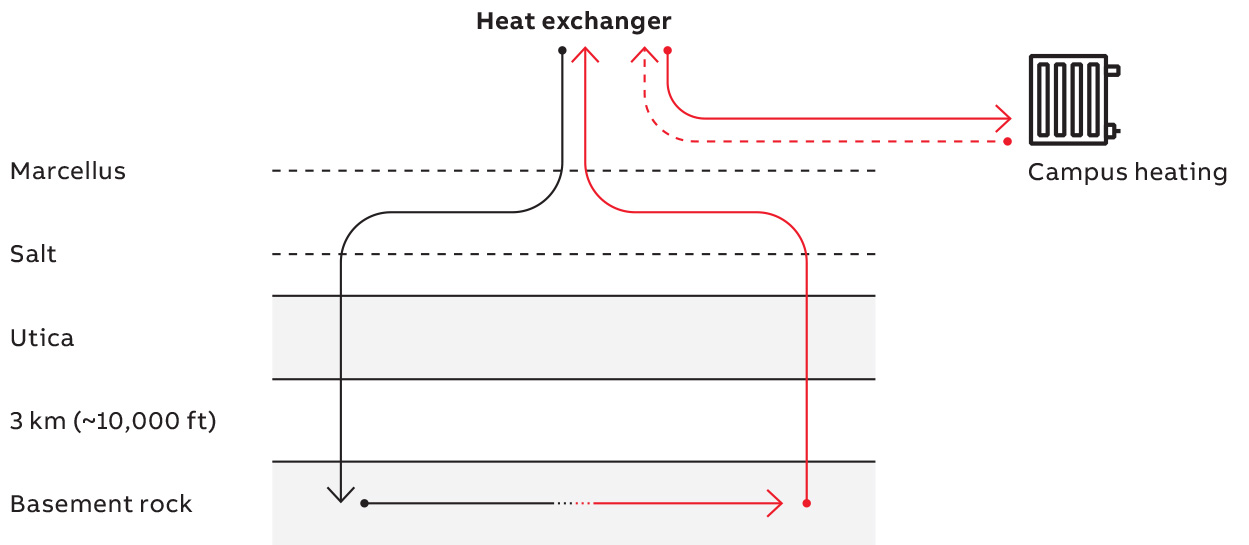Geothermal energy has warmed humans for millennia, with naturally heated water bubbling up through the earth’s crust, collecting in pools and funneled into pipes for use in cooking, heating and bathing. Harnessing this endless bounty of heat to help decarbonize modern society is fully feasible. It simply requires getting closer to the source.
“Accessing and utilizing deep geothermal energy is not that complicated a process,” says Dr. Jefferson W. Tester, Professor of sustainable energy systems in the Smith School of Chemical and Biomolecular Engineering at Cornell University and principal scientist for Cornell’s Earth Source Heat project. “The evolution of drilling in oil and gas has been significant, with both horizontal and extremely deep wells. Cost is really the main challenge. The technology needed to reach geothermal resources with useful stored energy is currently readily available.”
Deep impact, small footprint
Focus in the Earth Source Heat project is on using geothermal energy to heat buildings on Cornell’s Ithaca campus in central New York State, with wells reaching down to about 3,000 meters. By comparison, ultra-deep geothermal wells can penetrate to more than twice that depth, but the basic parameters remain unchanged.

“If we can do it in Ithaca, it can be done just about anywhere,” Tester maintains. Part of the proof backing up that claim is the minimal above-ground footprint of the operation: “Our facility can be built on one or two acres of land,” Tester confirms. “Drilling fluids are handled in closed tanks, so the operation is fully contained and controlled.”
Above-ground infrastructure at Cornell is already adaptable to hot water heating, Tester relates. “That means we can concentrate on demonstrating the underground technology to prove that sufficient energy production is possible from engineered reservoirs in our region. A successful project here can be used as a demonstration project for solutions that could be applied in many other places with similar geologic conditions.”
Meeting multiple needs
“We are in the middle of a transformation. At this point, the general public does not fully appreciate the potential of geothermal energy. With our cold climate in New York, we need to acknowledge that heating is a main consumer of energy in order to gain broader acceptance for the move to geothermal. In other settings, the motivation might come from meeting other needs,” Tester says.

He notes that Iceland, where naturally heated water has been used to heat homes and buildings for generations, is increasingly applying their abundance of geothermal energy to heat greenhouses that produce crops for domestic consumption, thus reducing the need for carbon-intensive imports.
Globally, industry and transportation are the biggest energy consumers. So how might deep geothermal knowledge and technology provide clean energy to industry, and the transport segments in particular?
Accessing and utilizing deep geothermal energy is not that complicated a process.
“The temperatures we are dealing with at Cornell, while efficient for heating, are too low for efficient production of electricity,” Tester relates. Conversely, temperatures provided by the deepest wells, 250oC or higher, provide good conversion efficiency. “With that kind of energy it is possible to produce green electricity or hydrogen that could be used to power factories or synthetic fuels for heavy transport.”
Seeing renewables as a system
“What we are talking about is really an energy system, put together in a way that makes sense environmentally and economically, providing the most value to consumers,” Tester emphasizes. “Every region has to look at their own options for renewables. Solar and wind are not enough by themselves to meet our total energy needs, nor is geothermal alone. If the main goal is to eliminate carbon, we have to open the door for multiple solutions together, and geothermal can fit well into the mix.”
The modest surface footprint of geothermal energy plants would allow them to be located in proximity to solar arrays or wind turbine farms, he points out. “Geothermal plants could provide a constant baseload power source to support more cyclical, intermittent sources like sun or wind.”
Deep geothermal energy hubs distributing power and producing energy carriers have also been proposed, Tester observes. “It’s a good idea, but why focus just on geothermal? We need to use all available resources, and if a hub were to include other renewable sources, the benefits could be even greater.”
If we can do it in Ithaca, it can be done just about anywhere.
Tester emphasizes the need to promote not just systems, but tradeoffs as well. “If we want to have a modern, sustainable society, we need to make clean power accessible to everyone. But what is the best way to get there?” With the Earth Source Heat project, Tester and his team are aiming to promote geothermal energy as an important, accessible piece of the zero-carbon puzzle.
